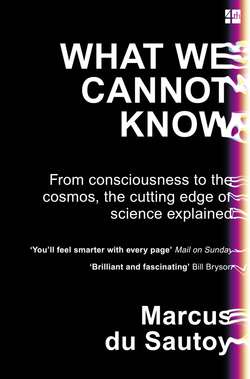Читать книгу What We Cannot Know: Explorations at the Edge of Knowledge - Marcus Sautoy du - Страница 35
A BUTTERFLY CALLED MERCURY
ОглавлениеPoincaré wasn’t able to answer the King of Sweden’s question about the solar system: whether it would remain in a stable equilibrium or might fly apart in a catastrophic exhibition of chaotic motion. His discovery that some dynamical systems can be sensitive to small changes in data opened up the possibility that we may never know the precise fate of the solar system much in advance of any potentially devastating scenario unfolding.
It is possible that, like population dynamics with a low reproductive rate, the solar system is in a safe predictable region of activity. Unfortunately, the evidence suggests that we can’t console ourselves with this comforting mathematical hope. Recent computer modelling has provided new insights which reveal that the solar system is indeed within a region dominated by the mathematics of chaos.
I can measure how big an effect a small change will have on the outcome using something called the Lyapunov exponent. For example, in the case of billiards played on differently shaped tables, I can give a measure of how catastrophic a small change will be on the evolution of a ball’s trajectory. If the Lyapunov exponent of a system is positive, it means that if I make a small change in the initial conditions then the distance between the paths diverges exponentially. This can be used as a definition of chaos.
With this measure several groups of scientists have confirmed that our solar system is indeed chaotic. They have calculated that the distance between two initially close orbital solutions increases by a factor of ten every 10 million years. This is certainly on a different timescale to our inability to predict the weather. Nevertheless, it means that I can have no definite knowledge of what will happen to the solar system over the next 5 billion years.
If you’re wondering in despair whether we can know anything about the future, then take heart in the fact that mathematics isn’t completely hopeless at making predictions. There is an event that the equations guarantee will occur if we make it to 5 billion years from now, but it’s not good news: the mathematics implies that at this point the Sun will run out of fuel and evolve into a red giant engulfing planet Earth and the other planets in our solar system in the process. But until this solar blowout engulfs the solar system, I am faced with trying to solve chaotic equations if I want to know which planets will still be around to see that red giant.
This means that, like the predictions of the weather, if I want to know what is going to happen, I am reduced to running simulations in which I vary the precise locations and speeds of the planets. The forecast is in some cases rather frightening. In 2009 French astronomers Jacques Laskar and Mickael Gastineau ran several thousand models of the future evolution of our solar system. And their experiments have identified a potential butterfly: Mercury.
The simulations start by feeding in the records we have of the positions and velocities of the planets to date. But it is difficult to know these with 100% accuracy. So each time they run the simulation they make small changes to the data. Because of the effects of chaos theory, just a small change could result in a large deviation in the outcomes.
For example, astronomers know the dimensions of the ellipse of Mercury’s orbit to an accuracy of several metres. Laskar and Gastineau ran 2501 simulations where they varied these dimensions over a range of less than a centimetre. Even this small perturbation resulted in startlingly different outcomes for our solar system.
You might expect that if the solar system was going to be ripped apart it would have to be one of the big planets like Jupiter or Saturn that would be the culprit. But the orbits of the gas giants are extremely stable. It’s the rocky terrestrial planets that are the troublemakers. In 1% of simulations that they ran, it was tiny Mercury that posed the biggest risk. The models show that Mercury’s orbit could start to extend due to a certain resonance with Jupiter, with the possibility that Mercury could collide with its closest neighbour, Venus. In one simulation, a close miss was enough to throw Venus out of kilter, with the result that Venus collides with Earth. Even close encounters with the other planets would be enough to cause such tidal disruption that the effect would be disastrous for life on our planet.
This isn’t simply a case of abstract mathematical speculation. Evidence of such collisions has been observed in the planets orbiting the binary star Upsilon Andromedae. Their current strange orbits can be explained only by the ejection of an unlucky planet sometime in the star’s past. But before we head for the hills, the simulations reveal that it will take several billion years before Mercury might start to misbehave.
